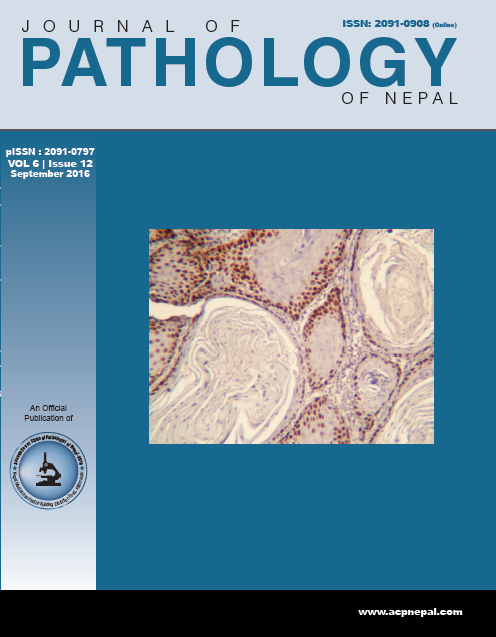Fine needle aspiration cytology of head and neck lesions and its correlation with histopathology
DOI:
https://doi.org/10.3126/jpn.v6i12.16276Keywords:
Fine needle aspiration cytology, Histopathology, Lymph node, Thyroid, Salivary gland, Soft tissuesAbstract
Background: Fine needle aspiration cytology is a minimally invasive technique used in the initial diagnosis of different types of lesions located in head and neck region commonly originating from cervical lymph node, thyroid gland, salivary glands and soft tissues. The objective of this study was to evaluate the diagnostic accuracy, sensitivity and speci city of FNAC in various head and neck lesions in correlation with their histopathological examination.
Materials and methods: A hospital based prospective study was conducted among 209 patients with palpable head and neck region swellings in the Department of Pathology, Bhaktapur Cancer Hospital and the Department of Pathology, Nepal Medical College from August 2014 to July 2015. FNAC were done from palpable masses of head and neck regions. Data entry and analysis were done using SPSS 17.
Result: There were 209 FNAC cases enrolled, out of which lymph node lesions (n=128) were the most common lesions followed by thyroid (n=40), other soft tissues (n=27) and salivary gland (n=14). Reactive lymph nodes, colloid goiter, epidermoid cyst and sialadenosis were the predominant diagnosis of lymph nodes, thyroid gland, soft tissues and salivary gland respectively. Highest accuracy, sensitivity and speci city were observed in thyroid gland, salivary gland and soft tissues. However, four false negative results for malignancy were reported in lymph node lesions.
Conclusion: Head and neck region swellings are the commonly encountered conditions. FNAC being highly accurate, sensitive and speci c makes it useful and reliable procedure for screening and diagnosis of palpable masses in head and neck region.
Downloads
Downloads
Published
How to Cite
Issue
Section
License
This license enables reusers to distribute, remix, adapt, and build upon the material in any medium or format, so long as attribution is given to the creator. The license allows for commercial use.




